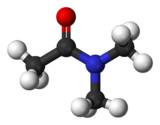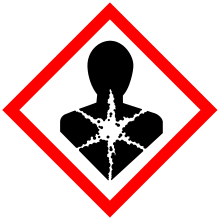Dimethylacetamide
 | |
 | |
| Names | |
|---|---|
| IUPAC name
N,N-Dimethylacetamide[1] | |
| Identifiers | |
| Abbreviations | DMAc[2] |
| 1737614 | |
| 127-19-5 | |
| ChEBI | CHEBI:84254 |
| ChEMBL | ChEMBL11873 |
| ChemSpider | 29107 |
| EC number | 204-826-4 |
| |
| Jmol-3D images | Image Image |
| MeSH | dimethylacetamide |
| PubChem | 31374 |
| RTECS number | AB7700000 |
| |
| UNII | JCV5VDB3HY |
| Properties | |
| Molecular formula |
C4H9NO |
| Molar mass | 87.12 g·mol−1 |
| Appearance | Colorless liquid |
| Odor | Ammoniacal |
| Density | 0.937 g mL−1 |
| Melting point | −20 °C (−4 °F; 253 K) |
| Boiling point | 165.1 °C; 329.1 °F; 438.2 K |
| Miscible | |
| log P | −0.253 |
| Vapor pressure | 300 Pa |
| UV-vis (λmax) | 270 nm |
| Absorbance | 1.00 |
| Refractive index (nD) |
1.4375 |
| Viscosity | 0.945 mPa s [3] |
| Thermochemistry | |
| Specific heat capacity (C) |
178.2 J K−1 mol−1 |
| Std enthalpy of formation (ΔfH |
−300.1 kJ mol−1 |
| Std enthalpy of combustion (ΔcH |
−2.5835–−2.5805 MJ mol−1 |
| Hazards | |
| GHS pictograms |   |
| GHS signal word | DANGER |
| H312, H332, H360 | |
| P280, P308+313 | |
| EU Index | 616-011-00-4 |
| EU classification | |
| R-phrases | R61, R20/21 |
| S-phrases | S45 |
| NFPA 704 | |
| Flash point | 63 °C (145 °F; 336 K) |
| 490 °C (914 °F; 763 K) | |
| Explosive limits | 1.8–11.5% |
| LD50 (Median lethal dose) |
|
| US health exposure limits (NIOSH): | |
| PEL (Permissible) |
TWA 10 ppm (35 mg/m3) [skin][4] |
| REL (Recommended) |
TWA 10 ppm (35 mg/m3) [skin][4] |
| IDLH (Immediate danger) |
300 ppm[4] |
| Related compounds | |
| Related compounds |
|
| Except where noted otherwise, data is given for materials in their standard state (at 25 °C (77 °F), 100 kPa) | |
| | |
| Infobox references | |
Dimethylacetamide (DMA) is the organic compound with the formula CH3C(O)N(CH3)2. This colorless, water-miscible, high boiling liquid is commonly used as a polar solvent in organic synthesis. DMA is miscible with most other solvents, although it is poorly soluble in aliphatic hydrocarbons.
Synthesis, reactions, applications
DMA is prepared by the reaction of dimethylamine with acetic anhydride and esters of acetic acid. Dehydration of the salt of dimethylamine and acetic acid also furnishes this compound:[5]
- CH3CO2H·HN(CH3)2 → H2O + CH3CON(CH3)2
The chemical reactions of dimethylacetamide are typical of N,N-disubstituted amides. It will hydrolyze in the presence of acids:
- CH3CON(CH3)2 + H2O + HCl → CH3COOH + (CH3)2NH2+Cl−
It is however resistant to bases. For this reason DMA is useful solvent for reactions involving strong bases such as sodium hydroxide.[6]
Dimethylacetamide is commonly used as a solvent for fibers (e.g., polyacrylonitrile, spandex) or in the adhesive industry.[5] It is also employed in the production of pharmaceuticals and plasticizers as a reaction medium.
Dimethylacetamide is also used as an excipient in drugs, e.g. in Vulmon (teniposide), Busulfex (busulfan) or Amsidine (amsacrine).
Toxicity
Dimethylacetamide is a medium potency reproductive toxicant (toxic for reproduction, category 1B).[7]
There are indications that dimethylacetamide is incompatible with polycarbonate or ABS. Devices (e.g. syringes) that contain polycarbonate or ABS dissolve when coming into contact with dimethylacetamide.[8]
Regulation
In 2011, dimethylacetamide was identified in the EU as a Substance of very high concern (SVHC).[9] In 2014, the European Commission has started an investigation to restrict the use of dimethylacetamide in the EU according to REACH.[10]
References
- ↑ "dimethylacetamide - Compound Summary". PubChem Compound. USA: National Center for Biotechnology Information. 2005-03-26. Identification. Retrieved 2012-04-19.
- ↑ Munro, D. D.; Stoughto, R. B. (1965). "Dimethylacetamide (DMAC) and Dimethylformamide (DMFA). Effect on Percutaneous Absorption". Archives of Dermatology 92 (5): 585–586. doi:10.1001/archderm.1965.01600170101020. PMID 5844405.
- ↑ Iloukhani, H., and K. Khanlarzadeh. "Densities, viscosities, and refractive indices for binary and ternary mixtures of N, N-dimethylacetamide (1)+ 2-methylbutan-2-ol (2)+ ethyl acetate (3) at 298.15 K for the liquid region and at ambient pressure." Journal of Chemical & Engineering Data 51.4 (2006): 1226-1231. DOI: 10.1021/je050538q
- ↑ 4.0 4.1 4.2 "NIOSH Pocket Guide to Chemical Hazards #0218". National Institute for Occupational Safety and Health (NIOSH).
- ↑ 5.0 5.1 Cheung, H.; Tanke, R. S.; Torrence, G. P. (2005), "Acetic Acid", Ullmann's Encyclopedia of Industrial Chemistry, Weinheim: Wiley-VCH, doi:10.1002/14356007.a01_045.pub2
- ↑ Zen, S.; Kaji, E. (1977). "Dimethyl nitrosuccinate". Org. Synth. 57: 60.; Coll. Vol. 6, p. 503
- ↑ European Chemicals Agency, Opinion on N,N-Dimethylacetamide (DMAC), 12 September 2014
- ↑ FDA warns health care professionals not to use Treanda Injection (solution) with closed system transfer devices, adapters, and syringes containing polycarbonate or acrylonitrile-butadiene-styrene – 10 March 2015
- ↑ Agreement of the Member State Committee on the Identification of N,N-Dimethylacetamide (DMAC) as a Substance of Very High Concern – Adopted on 24 November 2011
- ↑ Official Journal of the European Union, 19.8.2014, Commission Regulation (EU) No 895/2014
